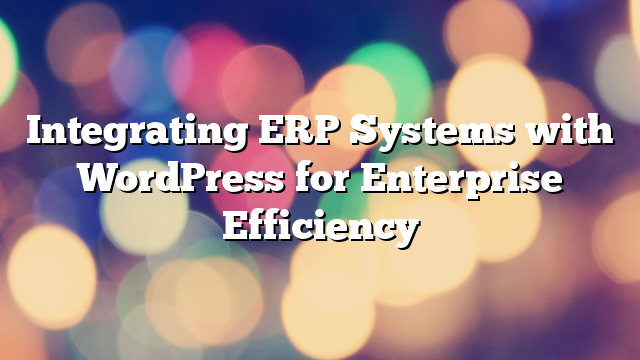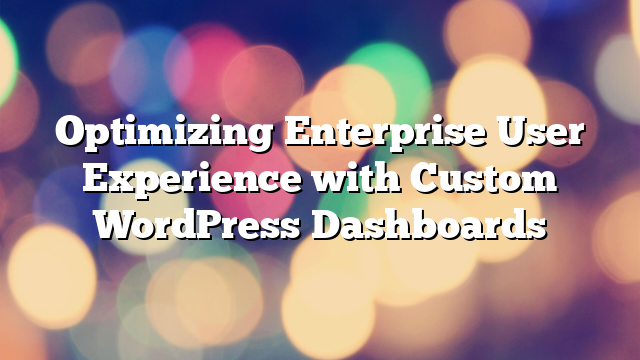Headless WordPress: The Future of Enterprise Content Management
20.10.2024

As enterprises seek to deliver faster, more scalable, and flexible digital experiences, headless WordPress has emerged as a powerful solution for content management. By decoupling the front-end from the back-end, headless WordPress allows enterprises to leverage the platform’s robust content management capabilities while using modern front-end technologies for a superior user experience. In this article, we’ll explore how headless WordPress is shaping the future of enterprise content management and how businesses can benefit from this architecture.
What is Headless WordPress?
Headless WordPress refers to the decoupling of the WordPress back-end (which manages content) from the front-end (which displays the content to users). In a traditional WordPress setup, both the front-end and back-end are tightly integrated, meaning WordPress handles both the content and the way it is presented. With a headless setup, the back-end is used purely for content management, while the front-end can be built using any modern technology, such as React, Next.js, Vue.js, or Angular.
How Headless WordPress Works
In a headless WordPress architecture, the WordPress back-end operates as a content repository. The content is delivered to the front-end via APIs, most commonly using the WordPress REST API or GraphQL. The front-end, built using a JavaScript framework or other technologies, fetches the content from WordPress and renders it for users.
This separation of concerns offers several advantages for enterprises, especially those looking to provide unique, high-performance digital experiences across multiple platforms, including websites, mobile apps, and even IoT devices.
Why Enterprises Are Adopting Headless WordPress
There are several reasons why enterprises are increasingly adopting headless WordPress for their content management needs:
- Flexibility in Front-End Development: By decoupling the front-end, enterprises can use the latest front-end technologies to create fast, interactive, and engaging user experiences. Whether it’s a progressive web app, a single-page application, or a custom interface for mobile, headless WordPress allows for more freedom in design and development.
- Improved Performance: Headless WordPress enables enterprises to optimize the front-end for speed, using technologies such as Next.js for server-side rendering and static site generation. This results in faster page load times and a better overall user experience, which is especially critical for high-traffic enterprise websites.
- Omnichannel Content Delivery: With headless WordPress, content is not limited to a single website. Enterprises can deliver content to multiple platforms—websites, mobile apps, digital kiosks, smart devices—through the same WordPress back-end, enabling a seamless omnichannel experience.
- Scalability: Headless WordPress is inherently more scalable than traditional WordPress. The back-end can handle content management at scale, while the front-end can be hosted separately, allowing enterprises to distribute traffic more efficiently across different servers and CDNs.
Key Benefits of Headless WordPress for Enterprises
1. Enhanced Security
One of the significant benefits of a headless WordPress setup is the enhanced security it offers. Since the front-end and back-end are decoupled, the WordPress admin area can be completely hidden from public view, reducing the attack surface for potential hackers. Additionally, the separation allows developers to implement advanced security measures for both the front-end and back-end independently.
2. Faster Time to Market
For enterprises looking to roll out new features or launch new platforms quickly, headless WordPress can significantly reduce the time to market. By using modern development frameworks like React or Next.js, teams can rapidly develop and deploy front-end applications while relying on WordPress to manage content. This flexibility allows businesses to be more agile and responsive to market changes.
3. Customization and Personalization
Headless WordPress allows enterprises to build highly customized front-end experiences that are tailored to user behavior. With the freedom to create unique interfaces and leverage data-driven design, businesses can offer personalized experiences that increase user engagement and satisfaction.
4. Future-Proof Technology Stack
By adopting a headless architecture, enterprises future-proof their technology stack. While WordPress continues to evolve as a content management platform, the front-end can be built with the latest frameworks and technologies, ensuring that the system remains modern and competitive as new tools and technologies emerge.
Implementing Headless WordPress with Next.js
One of the most popular front-end technologies used in headless WordPress setups is Next.js. As a React-based framework, Next.js offers server-side rendering, static site generation, and API routing, making it an excellent choice for building fast and scalable enterprise websites.
Here’s how enterprises can leverage Next.js with headless WordPress:
- Server-Side Rendering (SSR): Next.js allows pages to be rendered on the server, resulting in faster initial load times and better SEO. This is especially beneficial for enterprise websites with complex content structures.
- Static Site Generation (SSG): Enterprises can use Next.js to pre-render pages at build time, serving static content that loads instantly while still fetching dynamic data via APIs when necessary.
- API Integration: Next.js integrates seamlessly with the WordPress REST API or GraphQL, allowing developers to fetch content from the WordPress back-end and render it on the front-end with minimal delay.
Challenges and Considerations of Headless WordPress
While headless WordPress offers numerous benefits, there are some challenges and considerations that enterprises should be aware of:
- Development Complexity: A headless setup typically requires a more advanced technical stack, which may increase the complexity of development and maintenance. Enterprises need to ensure they have skilled developers familiar with both WordPress and modern front-end frameworks.
- Content Previewing: In a traditional WordPress environment, content editors can preview how content will appear on the front-end. In a headless setup, previewing content can be more challenging, requiring custom solutions to bridge the gap between the back-end and front-end.
- Increased Cost: Hosting and maintaining a decoupled system can be more expensive than a traditional WordPress installation, as the front-end and back-end may require separate infrastructure and scaling strategies.
Conclusion
Headless WordPress is revolutionizing enterprise content management by offering greater flexibility, performance, and scalability. As businesses seek to deliver content across multiple platforms and devices, headless architecture provides the agility and power needed to stay competitive in today’s digital landscape.
If your enterprise is ready to explore the benefits of headless WordPress, contact the experts at AllWebDev to learn more about how we can help you implement a tailored solution for your content management needs.



